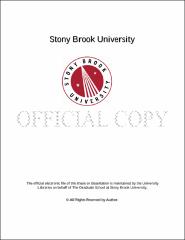| dc.identifier.uri | http://hdl.handle.net/11401/76858 | |
| dc.description.sponsorship | This work is sponsored by the Stony Brook University Graduate School in compliance with the requirements for completion of degree. | en_US |
| dc.format | Monograph | |
| dc.format.medium | Electronic Resource | en_US |
| dc.language.iso | en_US | |
| dc.publisher | The Graduate School, Stony Brook University: Stony Brook, NY. | |
| dc.type | Dissertation | |
| dcterms.abstract | Science research in the twenty-first century increasingly results in powerful and rapidly disseminated technologies that raise concerns over technological risk and public safety. A common recommendation for assessing and managing controversial research is to perform a quantitative risk-benefit analysis (RBA) in order to help determine an appropriate course of action. However, these recommendations lack guidelines on how to perform such an assessment. This dissertation lays out a detailed argument why a quantitative RBA should not be used as a basis for making complex policy decisions. Rather, RBA should be regarded as a tool for exploring the impacts of technology on society. This argument is made in four parts: (1) a comparison of the various legitimate, but incomparable ways that research benefits are assessed; (2) a guide to the many value-laden assumptions made in risk assessments that undermine unqualified claims of objectivity and neutrality; (3) a clarifying discussion of the technological risk attitudes that underlie research controversies; and (4) a discussion of how this inherent subjectivity favors particular risk management techniques. In applying these arguments to the use of RBA for controversial research, the concern is that RBA is unlikely to build consensus because the results of even the most mathematically sophisticated assessments tend to be too epistemically narrow or ethically controversial to resolve science policy disputes. These arguments are applied to a contemporary case study – controversial “gain-of-function†research involving highly pathogenic avian influenza. My analysis argues that the debate should place less emphasis on attempts to quantify current risks and benefits which are, in themselves, controversial. Rather, the least problematic resolution requires shifting away from traditional biosafety and biosecurity measures and towards more inherently safe research techniques that accomplish the same goals. This analysis is applicable to other contemporary research controversies such as those surrounding synthetic biology and geoengineering. | |
| dcterms.available | 2017-09-20T16:51:20Z | |
| dcterms.contributor | Ferguson, David | en_US |
| dcterms.contributor | Reaven, Sheldon J | en_US |
| dcterms.contributor | Tonjes, David | en_US |
| dcterms.contributor | Ferson, Scott. | en_US |
| dcterms.creator | Rozell, Daniel | |
| dcterms.dateAccepted | 2017-09-20T16:51:20Z | |
| dcterms.dateSubmitted | 2017-09-20T16:51:20Z | |
| dcterms.description | Department of Technology, Policy, and Innovation. | en_US |
| dcterms.extent | 216 pg. | en_US |
| dcterms.format | Application/PDF | en_US |
| dcterms.format | Monograph | |
| dcterms.identifier | http://hdl.handle.net/11401/76858 | |
| dcterms.issued | 2015-12-01 | |
| dcterms.language | en_US | |
| dcterms.provenance | Made available in DSpace on 2017-09-20T16:51:20Z (GMT). No. of bitstreams: 1
Rozell_grad.sunysb_0771E_12600.pdf: 1645608 bytes, checksum: 845b2141b65729c520d6d55690c67328 (MD5)
Previous issue date: 1 | en |
| dcterms.publisher | The Graduate School, Stony Brook University: Stony Brook, NY. | |
| dcterms.subject | Public policy | |
| dcterms.subject | avian influenza, inherent safety, R&D, risk analysis, technological risk attitudes, values | |
| dcterms.title | On Using Risk-Benefit Analysis to Assess and Manage Controversial Research | |
| dcterms.type | Dissertation | |

